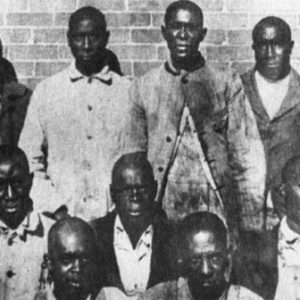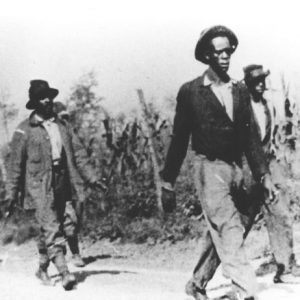calsfoundation@cals.org
Albert Giles (1898–1937)
Albert Giles was one of twelve African-American men accused of murder following the Elaine Massacre of 1919. After brief trials, the so-called Elaine Twelve—six who became known as the Moore defendants and six (including Giles) who became known as the Ware defendants—were found guilty of murder and sentenced to death. Ultimately, the Ware defendants were freed by the Arkansas Supreme Court in 1923; after numerous legal efforts, the Moore defendants were released in 1925.
Albert Giles was born in Louisiana on November 22, 1898, to Sallie T. Giles and an unidentified father. He moved to Phillips County, Arkansas, sometime in the early 1900s and was residing in Elaine (Phillips County) when he was drafted into the U.S. military on September 12, 1918. Nothing is known of his military service during World War I, but it is likely that he received an honorable discharge.
A 1916 federal study of plantation conditions in Arkansas warned that there was acute unrest due to the tenant farming system and oppressive landlords, and that this could lead to organized resistance. The Progressive Farmers and Household Union of America held a meeting on September 30, 1919, with black sharecroppers gathering at a church in the town of Hoop Spur (Phillips County), three miles north of Elaine (Phillips County). The purpose of the meeting was to seek more money for their crops from the landowners. Giles was working as a farm laborer at the time. An exchange of gunfire erupted, and W. A. Adkins, employed as a security officer for the Missouri Pacific Railroad, was killed, and Charles Pratt, a Phillips County deputy sheriff, was wounded; both were white. The shooting escalated into mob violence against the area’s black citizens, and although the exact number is unknown, estimates of the number of African Americans killed by whites range into the hundreds; five white people died.
Giles was subsequently arrested and charged with murder on October 31, 1919, along with eleven other black sharecroppers. These twelve men were sentenced to death. Their cases drew the attention of the National Association for the Advancement of Colored People (NAACP), and the civil rights lawyer Scipio Jones came to their defense. In December 1919, the men were granted a stay of execution by Governor Charles Brough, allowing for appeal. In March 1920, his death sentence, along with those of the five other Ware defendants (Ed Ware, William Wordlaw, Alfred Banks, Joe Fox, and John Martin), was reversed by the Arkansas Supreme Court, and they were sent back to Helena (Phillips County) for a new trial based on a technicality. A May 1920 retrial in Helena upheld the convictions. In December 1920, the Arkansas Supreme Court reversed the decision from Helena and called for a new trial. An April 1923 petition demanded the release of the prisoners due to the lack of trials for the last two court sessions, and on appeal, the Arkansas Supreme Court agreed, releasing Giles and the five others. The other six members of the Elaine Twelve, the Moore defendants, were released in 1925.
After his release from prison, Giles relocated to Springfield, Illinois, and began working as a bricklayer. He married Mary Wheatley sometime before 1930, while he was residing in Springfield. Giles was drawn into a life of crime and arrested numerous times for a variety of offenses throughout the 1930s. He was apprehended by police in 1931 and charged with possession and sale of liquor (illegal in those Prohibition years) as well as maintenance of nuisances. Giles pleaded “no contest” to the charge of running a speakeasy at his residence and was sentenced to time served, resulting in his release from city prison. The day after he was freed, Giles pistol-whipped a man named Andrew Toney and was jailed again. Giles claimed that the assault was revenge for Toney striking Giles’s wife while Giles was in prison. He was released on bond that night. In 1934, Giles was arrested for disorderly conduct after engaging in a fight with Willie Newton but was released soon after. Giles and seven other men were arrested and charged with gambling in a police raid in 1935, and he was again released after paying his bond. In 1936, Giles was arrested for attacking a woman named Irene Hanna. The two had apparently been arguing, and Giles slashed her face with a knife after she bit him.
The end of Giles’s life was further met by violence. In 1937, he was involved in a gunfight with his neighbor, Sherman Smith, and was seriously wounded and hospitalized. Both men were charged with assault with intent to kill, but a “no true bill” was returned in this case. His final arrest came later that year when he and three others were involved in an incident in which one man was shot and a woman was cut with a knife. On December 20, 1937, Giles was left in critical condition after he was beaten by a man named Louis Sparks. He died in a Springfield hospital on December 25, 1937. He was survived by his mother, Sallie T. Giles, a brother, James, and a sister, Anna, all of Little Rock (Pulaski County). Giles is buried in the World War I veterans’ section of Oak Ridge Cemetery in Springfield.
For additional information:
“Assaulted Man Is Dead; One Held for Homicide.” Daily Illinois State Journal, December 26, 1937, p. 6.
Cortner, Richard C. A Mob Intent on Death: The NAACP and the Arkansas Race Riot Cases. Middletown, CT: Wesleyan University Press, 1988.
“Jury Asks Slayer Be Held to Grand Jury.” Daily Illinois State Journal, December 28, 1937, p. 10.
Lancaster, Guy, ed. The Elaine Massacre and Arkansas: A Century of Atrocity and Resistance, 1819–1919. Little Rock: Butler Center Books, 2018.
Stockley, Grif, Brian K. Mitchell, and Guy Lancaster. Blood in Their Eyes: The Elaine Massacre of 1919. Rev. ed. Fayetteville: University of Arkansas Press, 2020.
Whitaker, Robert. On the Laps of Gods: The Red Summer of 1919 and the Struggle for Justice that Remade a Nation. New York: Crown, 2008.
Brian K. Mitchell, Alex Soulard, Kathryn Thompson
University of Arkansas at Little Rock


 Elaine Massacre Defendants
Elaine Massacre Defendants  Elaine Massacre Defendants
Elaine Massacre Defendants  Elaine Massacre Prisoners
Elaine Massacre Prisoners 



Comments
No comments on this entry yet.